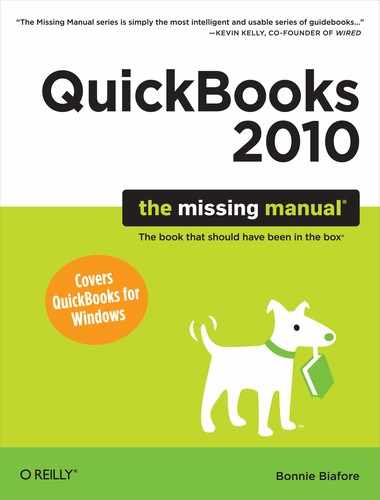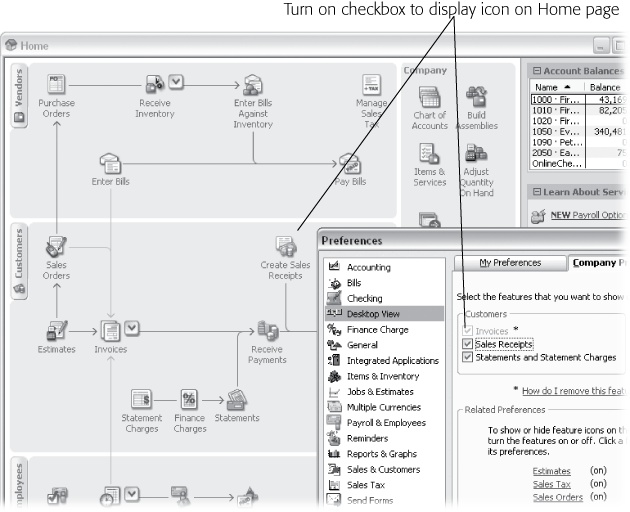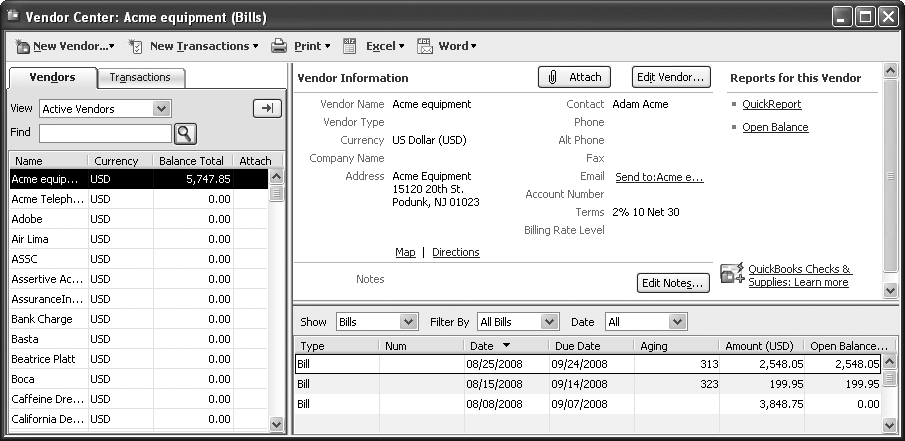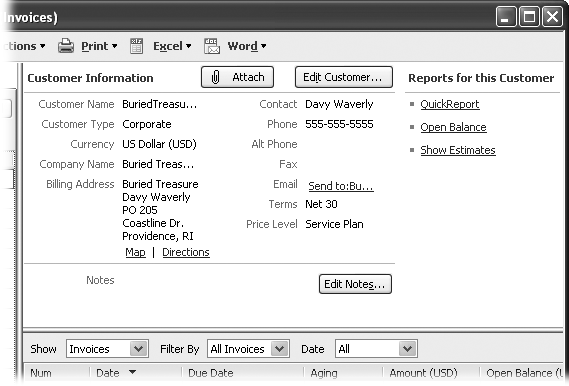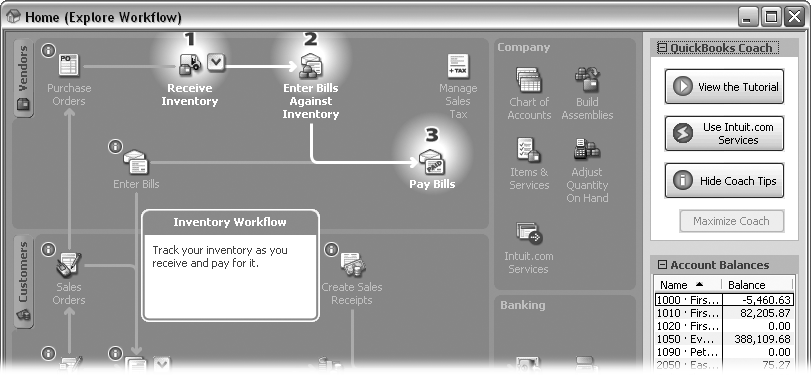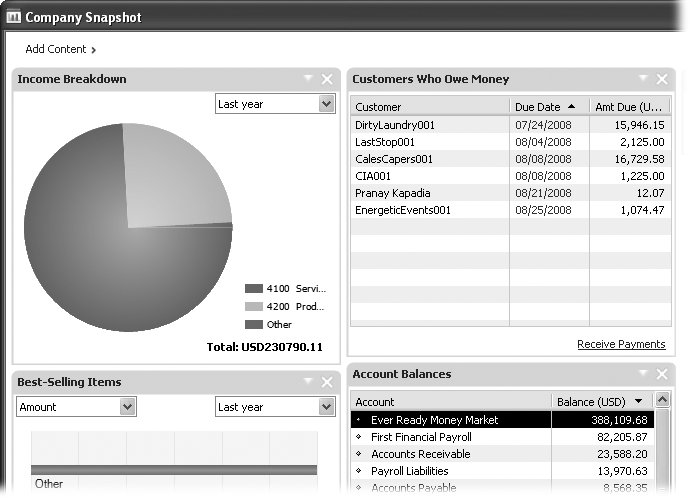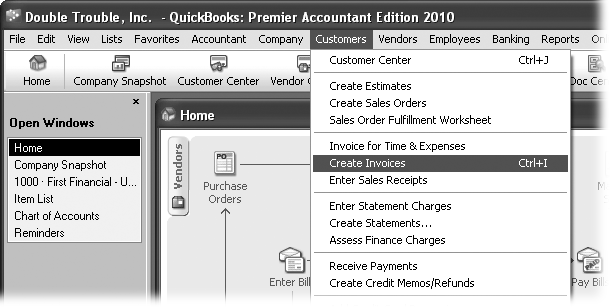Chapter 2. Getting Around in QuickBooks
You have enough to do running your business, so you don’t want bookkeeping to take any longer than necessary. The QuickBooks Home page is a visual roadmap to the bookkeeping tasks you use regularly. It has panels for tasks related to vendors, customers, and employees, giving you quick access to the commands and financial info you use most often. Click an icon, and the corresponding window or dialog box appears. The Home page has other icons in the Company and Banking panels that open the windows you use most often. The Vendors, Customers, and Employees buttons on the left side of the window open centers that let you manage those groups. This chapter explains how to use the workflow icons and the centers.
You’ll also learn how to review your company finances in the Company Snapshot window and access QuickBooks commands from the menu bar and icon bar. Finally, you’ll learn how to work with all the windows you open during a rousing bookkeeping session.
Getting Around the QuickBooks Home Page
The QuickBooks Home page (Figure 2-1) is a slick way to work through your company’s bookkeeping tasks. When you create your company file with the EasyStep Interview (Company Information), you tell QuickBooks what you want to see on the Home page. For example, if you invoice customers and send statements, the Customers panel can show the tasks for invoicing and preparing statements. But if you run a one-person shop and don’t have employees, you can make sure the Employees panel is nowhere to be seen.
The Home page also has icons for other must-do tasks—like Chart of Accounts (Company section) to open the Chart of Accounts window and Check Register (Banking section) to open your checking account register window. This section shows you how to use the Home page to best advantage.
Tip
To make sure the Home page appears each time you log in, click the My Preferences tab and turn on the “Show Home page when opening a company file” checkbox. If you prefer to choose commands from menus and want to keep the Home page hidden, turn this checkbox off.
The Home page gives you an overview of your bookkeeping tasks. It lets you see how everything fits together so you can follow your money from start to finish. Vendors, customers, and employees each have their own panel of activities. The bookkeeping tasks for each group are laid out like breadcrumbs you can follow from beginning to end. Each company is different, so you don’t have to use every icon you see. This section outlines the tasks in each panel and where you can find detailed instructions elsewhere in this book.
Vendors
Whether you order products and services to run your company or to sell to your customers, the Vendors panel steps you through purchasing and paying for the goods and services you use (as you can see at the top of Figure 2-2), all of which are described in detail in Chapter 9. The Vendors button on the left side of the panel opens the Vendor Center, where you can set up or edit vendors. The Vendor Center is the best place to create, edit, and view what’s going on with the vendors you work with. On the left side of the Home page, click Vendors or choose Vendors → Vendor Center to open the Vendor Center window.
Here’s what you can do in the Vendor Center and where to find detailed instructions in other chapters:
Create a new vendor. In the Vendor Center toolbar, click New Vendor. The New Vendor window opens so you can create a new vendor record, as described on Entering Address Information.
Find a vendor. If you have a bazillion vendors, you can shorten the vendor list that you see. The View drop-down list is initially set to Active Vendors. Choose “Vendors with Open Balances” if you want to see only the vendors you owe money to. Choose Custom Filter to specify exactly the criteria you want. On the other hand, if you want to see active and inactive vendors alike, choose All Vendors.
For a quick search of vendor records, type part of the vendor name in the Find box and then click the Find button (the icon looks like a magnifying glass).
Review a vendor record. When you select a vendor on the Vendors tab, shown in Figure 2-2, basic info about the vendor appears on the right side of the window.
Figure 2-2. The Vendor Center puts all vendor-related tasks in a single window. When you choose a vendor, the right pane displays info about that vendor and its transactions. To attach an electronic vendor document like a bill to the vendor’s record, click the Attach button on the right pane. If the vendor record includes an email address, you can click the “Send to” link next to the Email label to email the vendor. You can even click the Map or Directions links to find out how to get to your vendor’s location.Edit an existing vendor’s record. To change a vendor’s record, on the Vendors tab, right-click the vendor name and then choose Edit Vendor. The Edit Vendor window opens with the same fields you filled in when you created the record. If you’ve selected the vendor in the list, you can also click the Edit Vendor button on the right pane.
Attach an electronic document to a vendor record. You can attach electronic documents to a vendor record (and even scan them right in QuickBooks). See Setting Print Options to learn more about this new QuickBooks 2010 feature.
Create transactions for a vendor. In the Vendor Center toolbar, click New Transactions to display a drop-down menu of vendor-related commands like Enter Bills, Pay Bills, and Receive Items. (These do the same thing as the icons in the Vendors panel of the Home page.)
Review transactions for a vendor. When you select a vendor on the Vendors tab, the table at the bottom-right of the Vendor Center lists that vendor’s transactions. By filtering the transactions, you can find out which purchase orders are still open, whether any bills are overdue, or the payments you’ve made. To limit the transaction list to only a specific type of transaction, in the Show drop-down list, choose the transaction type like Bills or Bill Payments.
The Filter By drop-down list lets you restrict the transactions you see by their status, such as Open Bills or Overdue Bills. To track down transactions within a date range, choose the date range in the Date drop-down list. (The date range options in this menu are the same as the ones available in reports; see Date Ranges.)
Print or export vendor information. In the Vendor Center toolbar, click Print or Excel to print or export vendor info (Exporting Reports). If you click Excel, you can choose “Import from Excel” to import vendor records into QuickBooks, which works similarly to importing customer records as described on Importing Customer Information.
Prepare vendor letters. In the Vendor Center toolbar, click Word to create letters to vendors (Mail Merge to a Word Document).
Customers
Like its vendor sibling, the Customers panel has icons for customer-oriented commands for creating invoices, statements, sales receipts, and so on. (Chapter 10 describes in detail how to work with invoices, estimates, sales orders, refunds, and customer credits. Chapter 11 covers the commands for creating statement charges and statements. Receiving payments and sales receipts for cash sales are both described in Chapter 13.) The Customers button on the left side of the panel (or choose Customers → Customer Center) opens the Customer Center, which lets you create new customer records and transactions, edit existing ones, or check on their status. Here are customer tasks you can perform from the Customer Center:
Create a new customer or job. In the Customer Center toolbar, click New Customer & Job. On the drop-down menu, choose New Customer to create a new customer record (Creating a New Customer). If you want to add a job to a customer, first select the customer on the Customers & Jobs tab. Then, choose New Customer & Job → Add Job (Creating a New Job).
Find a customer. You can filter the customer list to show active customers, only customers with open balances (those who owe you money), or all customers. Choose Custom Filter to specify criteria for the customers you want to see. To search for a specific customer, type part of the customer name in the Find box, and then click the Find button (the icon looks like a magnifying glass).
Review a customer record. When you select a customer on the Customers & Jobs tab, the right side of the window displays the basic 411 about the customer. In the Customer Information section, shown in Figure 2-3 you can send an email to the customer, attach electronic documents, get directions to their location, add notes to the record, or run reports about the customer.
Edit an existing customer’s record. On the Customers & Jobs tab, right-click the customer name and then choose Edit Customer. The Edit Customer window opens, filled in with the values you entered when you created the record.
Attach an electronic document to a customer record. You can attach electronic documents to a customer record (or scan them right in QuickBooks). See Setting Print Options to learn more about this new QuickBooks 2010 feature.
Create transactions for a customer. In the Customer Center toolbar, click New Transactions and then choose one of the commands from the drop-down menu, such as Estimates, Invoices, or Receive Payments. The commands on the drop-down menu are the same as the icons in the Customers panel of the Home page.
Review transactions for a customer. The table at the bottom-right of the Customer Center lists the transactions for the customer you select on the Customers & Jobs tab. You can filter the transactions you see (Accounts Receivable Aging Reports) by type (estimates or invoices, for example), status, and date. Double-click a transaction in the list to open the corresponding window to that transaction.
Print or export customer information. In the Customer Center toolbar, click Print or Excel to print or export customer and job info (Exporting Reports). If you click Excel, you can choose Import from Excel to import customer records into QuickBooks (Importing Customer Information).
Prepare customer letters. In the Customer Center toolbar, click Word to create letters to customers (Mail Merge to a Word Document).
Employees
The Employees panel has only a few icons. The devilish details arise when you click one of the icons to enter time, set up paychecks, or pay payroll tax liabilities. The Employee Center works the same way as the Vendor and Customer Centers. To see it, click Employees on the left side of the Home page or choose Employees → Employee Center. (See Chapter 8 to learn how to record the time that employees work. Chapter 14 walks you through paying employees and other payroll expenses.)
In the Employee Center, you can create new records for employees, update info for existing employees, and view transactions like paychecks. On the Employees tab, you can filter the employee list to view active employees, released employees (the ones that no longer work for you), or all employees.
Company Features
The Company section appears on the right side of the Home page. The two icons that you’ll probably click often are Chart of Accounts and Items & Services, which open the Chart of Accounts (Creating an Account) and Item List (Creating Items) windows, respectively. If you track inventory, the Adjust Quantity On Hand icon lets you change the quantity and value of your inventory (Adjusting Quantities).
Banking
The Banking section is a one-stop-shop for banking tasks. Whether you visit this section frequently or almost never depends on how you like to record transactions. For example, you can click the Write Checks icon to open the Write Checks window (Using the Write Checks Window) or simply press Ctrl+W to do the same thing. Or, if you prefer to record checks in a check register window, you might prefer to double-click your bank account in the Chart of Accounts window. Similarly, the Enter Credit Card Charges icon opens the Enter Credit Card Charges window (Paying with Cash), but you can record credit card charges directly in a credit card register (Opening a Register Window).
The Record Deposits icon opens the “Payments to Deposit” dialog box, so you can record bank deposits (Recording Deposits) in QuickBooks. The Reconcile icon opens the Begin Reconciliation dialog box, so you can reconcile your QuickBooks records to those of your bank (Starting a Reconciliation). The Print Checks icon opens the Select Checks to Print dialog box, so you can select the checks you want to print and send them to the printer loaded with your checks.
Note
The far right side of the Home page shows account balances and a link to display reminders. However, the new Company Snapshot window (Changing icon appearance) shows this information and more.
The QuickBooks Coach
The QuickBooks Coach can help you learn how to use the program. When you first install QuickBooks, the Coach is turned on, which means that the QuickBooks Coach section appears at the top-right of the Home page, as shown in Figure 2-4. To see tips that help you decide what to do, click the blue circle with an “i” inside. A pop-up box tells you what the Home page steps do and shows the order in which you perform them.
The Company Snapshot
The Company Snapshot window (choose Company → Company Snapshot) is a financial dashboard that can show important aspects of your company’s financial state like account balances, income breakdown (by top-level income accounts), customers who owe money, and best-selling items, as you can see in Figure 2-5. In QuickBooks 2010, you can choose from 12 different financial views (Changing icon appearance) so the Company Snapshot can show the financial information you care about most.
Using Menus and the Icon Bar
Although the QuickBooks Home page guides you through bookkeeping tasks, QuickBooks’ veterans may still prefer the menu bar (Figure 2-6) to launch the program’s tools for different financial activities. Unlike other navigation features, the menu bar is always available, and it serves up every command that QuickBooks has to offer.
After shortcut menus and keyboard shortcuts (see Appendix C at www.missingmanuals.com/cds), the QuickBooks icon bar is the fastest way to launch your favorite commands. You can add your favorite commands, memorized reports, or windows you open often. You can also remove commands that you no longer use. Building Your Favorites Menu tells you how to add icons for all these items to the icon bar and how to change their appearance.
Switching Between Open Windows
If you tend to work on one bookkeeping task for hours on end, you can set QuickBooks up to display one full-size window at a time (Choosing the Online Banking Mode). If you open additional windows, they stack on top of each other so you see the last one you opened. With the one window approach, you can view another window by choosing it in the Open Window List, on the left in Figure 2-7. (Or on the menu bar, choose Window and then choose the name of the window you want to display.) If the Open Window List isn’t visible, choose View → Open Window List.
When you flit between bookkeeping tasks like a honey bee in an alfalfa field, you probably want several windows open at a time. QuickBooks can display several windows at the same time, as shown on the right in Figure 2-7. Like windows in other programs, you can click a window to bring it to the front, reposition windows by dragging their title bars, or resize windows by dragging their edges and corners.
Tip
Everyone who uses QuickBooks can work with windows the way they want. To tell QuickBooks how you want the desktop to look when you run the program, see Preferences for Saving the Desktop.
